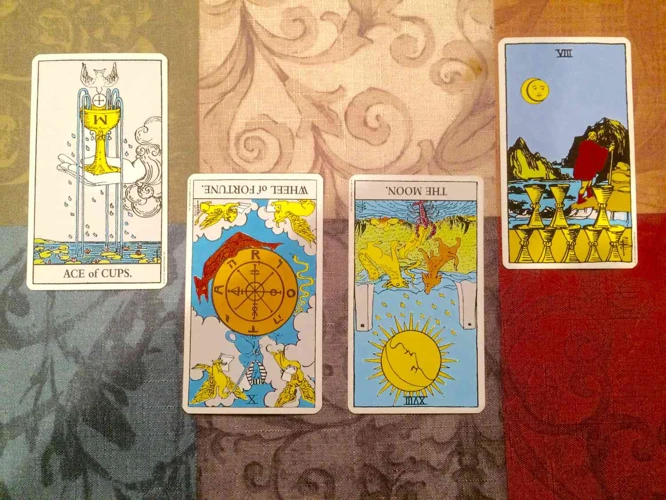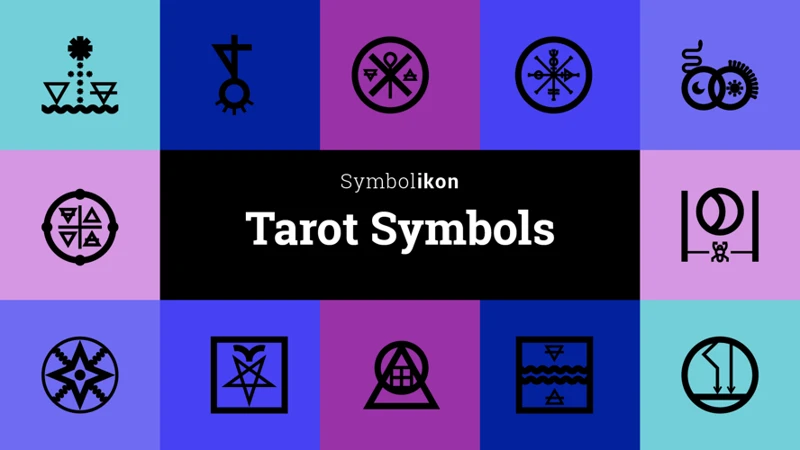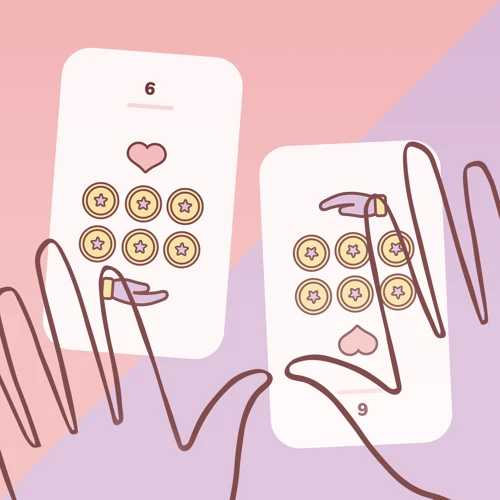Welcome to a fascinating exploration of the world of tarot. In this article, we will delve into the realm of reversed tarot cards and discover creative techniques for interpreting them. Reversed cards are like a mirror reflecting a different perspective, offering unique insights and deeper meanings. Through the blending of traditional symbolism and intuitive interpretation, we will uncover the hidden messages and uncover new possibilities within the reversed tarot cards. So, let us embark on this journey and unlock the secrets that lie within the reversed tarot cards.
Contents
- Why Interpret Reversed Tarot Cards?
- Traditional Symbolism vs. Intuitive Interpretation
- Techniques for Interpreting Reversed Tarot Cards:
- Blending Traditional and Creative Approaches
- When to Trust Your Intuition
- Conclusion
-
Frequently Asked Questions
- 1. Can reversed tarot cards be interpreted differently from upright cards?
- 2. Are reversed tarot card readings less accurate than upright readings?
- 3. Should I interpret reversed tarot cards as completely negative?
- 4. Do reversed tarot cards always have opposite meanings from upright cards?
- 5. How can I incorporate reversed tarot cards into my readings?
- 6. Are there specific spreads for reading reversed tarot cards?
- 7. Can I ignore reversed tarot cards during a reading?
- 8. Is it possible to have all cards in a tarot spread appear reversed?
- 9. Do reversed tarot cards have different elemental associations?
- 10. Where can I find a comprehensive list of upright and reversed tarot card meanings?
- References
Why Interpret Reversed Tarot Cards?

Interpreting reversed tarot cards adds a layer of depth and complexity to tarot readings. While upright cards already provide valuable insights, reversed cards offer a contrasting perspective that can enhance understanding. It is important to interpret reversed cards because they represent blocked energy, obstacles, or hidden aspects in a person’s life. They can reveal suppressed emotions or unresolved issues that need to be addressed for personal growth and transformation. By delving into the reversed meanings of tarot cards, we unlock a wealth of information that can guide us towards finding solutions or resolutions to challenges that may be hindering progress.
Traditional Symbolism vs. Intuitive Interpretation

When it comes to interpreting reversed tarot cards, there are two main approaches: traditional symbolism and intuitive interpretation. Traditional symbolism relies on the established meanings and associations of each card in its upright position, but with a twist when it appears upside down. For example, a card that represents abundance and prosperity may indicate scarcity or financial setbacks when reversed. This method is rooted in the history and traditional interpretations of tarot.
On the other hand, intuitive interpretation encourages readers to trust their instincts and tap into their intuition when interpreting reversed cards. Instead of adhering strictly to conventional meanings, the reader allows their intuition to guide them towards a deeper understanding of the reversed card’s message. This approach embraces personal insights, symbolisms, and unique connections between the cards, empowering the reader to offer a more personalized and nuanced reading.
Both traditional symbolism and intuitive interpretation have their merits, and many tarot readers choose to blend both approaches to gain a comprehensive understanding of the reversed tarot cards. By combining established symbolism with intuitive insights, readers can tap into a wider range of meanings and provide clients with a more holistic interpretation of their tarot spreads.
To explore traditional symbolism further, you can check out our article on the role of elemental associations in reversed tarot card readings. For those interested in different tarot spreads, our article on tarot reversed spreads offers insightful options to enhance your readings. Understanding the differences between upright and reversed tarot meanings can also provide valuable insights, which you can find in our article on upright and reversed tarot meanings.
Techniques for Interpreting Reversed Tarot Cards:

Interpreting reversed tarot cards requires a combination of traditional and creative techniques that go beyond the conventional meanings. Here are five techniques that can help unlock the deeper meanings of reversed cards:
- 1. Elemental Balance: Consider the elemental associations of the reversed card to gain insight into the underlying energies at play. Explore how the reversed card interacts with the elemental qualities of its suit and how that influences the overall interpretation.
- 2. Numerology: Dive into the numerological significance of the reversed card. Each number has its own symbolic meaning, and understanding the numerological aspects can provide additional insights into the reversed card’s message.
- 3. Mirror Reflections: View the reversed card as a mirror image that reflects a different perspective. Analyze the symbolism and imagery within the card and consider how it contrasts or complements the meaning of the upright position.
- 4. Card Pairings: Examine the reversed card in combination with other cards in the spread. Look for patterns, connections, or contrasts between the reversed card and its neighboring cards to understand the relationships and themes within the reading.
- 5. Elemental Reversals: Explore the reversal of elemental qualities within the card. For example, if a fire card is reversed, it may indicate a loss of passion or motivation. Analyzing these elemental reversals can deepen the interpretation of the reversed card.
By using these techniques, tarot readers can develop a comprehensive understanding of reversed cards and uncover hidden insights that can provide guidance and inspiration.
1. Elemental Balance
- When interpreting reversed tarot cards using the technique of Elemental Balance, we focus on the elemental associations of each card. Each tarot suit corresponds to one of the four elements: Cups for water, Wands for fire, Pentacles for earth, and Swords for air. By considering the elemental balance in a reversed card, we can gain insights into the imbalances or conflicts present in a situation or within ourselves.
- For example: If a reversed Cups card appears, it may indicate emotional turmoil or strained relationships. This imbalance suggests the need for emotional healing or better communication in our lives.
- Or: If a reversed Wands card shows up, it could represent a lack of motivation or creative blockage. This imbalance calls for us to realign our passions and find inspiration to overcome obstacles.
2. Numerology
- Numerology offers a powerful tool for interpreting reversed tarot cards. Each tarot card in the deck corresponds to a number, and these numbers hold significant meaning. When a card appears reversed, its number can provide additional insight into the reversed interpretation. For example, the Two of Cups reversed may indicate a lack of balance or harmony in relationships, while the Seven of Swords reversed could suggest the need to overcome challenges and regain personal power.
- To interpret reversed tarot cards using numerology, start by noting the number associated with the card. Then, explore the meaning of that number. Consider its symbolism, such as its representation of duality, harmony, or challenge. Connect the number’s essence to the reversed message of the card, and you will gain a deeper understanding of its significance.
- Remember that numerology may not provide a direct answer but rather serves as a guide, offering potential interpretations and avenues for exploration. It adds another layer of meaning to your tarot readings and helps you tap into the deeper wisdom and symbolism of the cards.
3. Mirror Reflections
Mirror reflections is a powerful technique for interpreting reversed tarot cards. Just as a mirror reflects our physical appearance, reversed tarot cards reflect a different perspective or hidden aspects of a situation. To apply this technique, first, observe the imagery and symbolism on the reversed card. Look for elements that might be reversed or mirrored in some way. This could include reversed positions of figures, symbols, or objects within the card. Pay attention to how this reversal affects the overall meaning of the card. For example, if a card traditionally symbolizes stability and strength, its reversed counterpart may indicate a loss of stability or a weakening of strength.
Analyze the reversed card by considering what the mirror reflection is trying to convey. Is it suggesting the need for inner reflection or a change in perspective? The mirror reflection technique encourages us to explore the opposite nature of the reversed card’s energy and how it is influencing the overall reading. It prompts us to question whether the reversed card represents an obstacle or an opportunity for growth. By immersing ourselves in the mirror-like qualities of the reversed card, we gain a deeper understanding of its significance and interpret it in relation to the surrounding cards and the querent’s specific situation.
4. Card Pairings
Card pairings are a powerful technique for interpreting reversed tarot cards. When two cards appear together in a reading, their energies combine and influence each other, creating a unique narrative. When interpreting reversed cards in the context of a card pairing, pay attention to the interactions between the two cards. Look for contrasts, similarities, or any patterns that emerge. The reversed card can provide insights into the challenges, obstacles, or hidden aspects represented by the upright card. It can also indicate the need for a different approach or mindset to navigate the situation. For example, if the upright card represents love and the reversed card represents the Three of Swords, it suggests that there may be some emotional pain or heartbreak in a romantic relationship. The combination of the two cards highlights the need for healing and resolving conflicts. By analyzing card pairings with reversed cards, we uncover a deeper understanding of the situation and gain valuable guidance on how to navigate the challenges presented.
5. Elemental Reversals
When interpreting reversed tarot cards, one effective technique is to consider the elemental associations and reversals. Each tarot suit corresponds to one of the four elements – Wands for Fire, Cups for Water, Swords for Air, and Pentacles for Earth. Reversed cards can indicate imbalances or disruptions in these elements, offering valuable insights into the situation at hand.
Fire (Wands) Reversal: Reversed Fire cards may suggest a lack of motivation, energy, or passion. It could indicate difficulties in taking action or making progress towards goals. It’s important to assess what is hindering the individual’s drive and find ways to reignite their passion.
Water (Cups) Reversal: Reversed Water cards may signify emotional blockages, unresolved feelings, or difficulties in connecting with one’s emotions. It is crucial to explore the depths of one’s emotional state and find healthy ways to express and process these emotions.
Air (Swords) Reversal: Reversed Air cards can represent confusion, mental blocks, or miscommunication. It may indicate distorted thinking patterns that need to be addressed. Developing clarity, open communication, and a rational mindset are advisable in such situations.
Earth (Pentacles) Reversal: Reversed Earth cards suggest issues related to stability, finances, or physical well-being. It can indicate a struggle to manifest goals or financial hardships. It’s important to review one’s approach to money, work, and material possessions to overcome these challenges.
By considering the elemental associations in reversed tarot cards, we can gain deeper insights into the imbalances present in a person’s life and guide them towards restoring harmony and balance in the respective areas.
Blending Traditional and Creative Approaches

Blending traditional and creative approaches is a powerful way to interpret reversed tarot cards. Traditional tarot symbolism provides a solid foundation and framework for understanding each card’s meaning. It is essential to have a solid grasp of the traditional upright interpretations of the cards before diving into the reversed meanings. This allows us to discern the subtle nuances and differences when a card appears in its reversed position.
However, relying solely on traditional meanings can limit our perspective and creativity. By incorporating intuitive and creative approaches, we can tap into our own insights and imagination. This involves trusting our intuition and allowing our subconscious mind to guide us in interpreting the reversed cards. It may involve drawing associations from personal experiences, dreams, or symbols that resonate with us on a deeper level.
One technique for blending traditional and creative approaches is to explore the role of elemental associations in reversed tarot card readings. Each tarot suit corresponds to an element – Wands with fire, Cups with water, Swords with air, and Pentacles with earth. Understanding the elemental energies at play in a reversed card can provide additional layers of meaning and insights into the blockages or challenges being represented.
Another creative approach is to explore reversed tarot spreads. These are specific layouts or patterns designed to help us interpret the reversed energies in a reading. They provide a structured framework that allows us to explore the relationship between the reversed cards and their positions. Reversed tarot spreads can reveal hidden connections, patterns, or perspectives that may not be immediately apparent when reading individual cards in isolation.
By blending traditional symbolism with creative techniques, we can uncover a broader range of interpretations and gain a deeper understanding of the reversed cards in a tarot reading. This fusion allows for a more comprehensive and nuanced exploration of the messages and insights that the reversed tarot cards hold.
When to Trust Your Intuition
Trusting your intuition is crucial when interpreting reversed tarot cards. While there are traditional meanings associated with each card, it is important to rely on your own inner guidance and instincts when working with reversed cards. Your intuition can provide valuable insights and help you connect with the deeper symbolism and messages that may not be apparent at first glance. Here are some key indicators of when to trust your intuition:
- Gut Feeling: If you have a strong intuitive sensation or gut feeling about a particular interpretation, it is important to trust it. Your subconscious mind may be picking up on subtle cues or information that your conscious mind may not be aware of.
- Strong Emotional Response: If a reversed card elicits a strong emotional response within you, it could be a sign that it holds significant personal meaning. Pay attention to your emotional reactions as they can provide valuable clues.
- Synchronicities: If you notice recurring symbols, themes, or patterns in multiple reversed cards, it is a sign that the universe is trying to communicate something to you. Trust your intuition to decipher these synchronicities and uncover their deeper significance.
- Personal Connection: If a specific interpretation resonates strongly with you on a personal level, it is a good indication that you are tapping into the authentic message of the card. Trust your intuition to guide you towards the most relevant and meaningful interpretation.
Remember, tarot is a highly personal and intuitive practice. While it is important to understand the traditional meanings of reversed cards, ultimately, it is your intuition that will guide you towards the most accurate and insightful interpretations.
Conclusion
In conclusion, interpreting reversed tarot cards opens up a world of possibilities in a tarot reading. By incorporating creative techniques such as elemental balance, numerology, mirror reflections, card pairings, and elemental reversals, we can glean deeper insights and uncover hidden meanings within the reversed cards. Blending traditional symbolism with intuitive interpretation allows us to tap into our own intuition and connect with the messages the cards are trying to convey. Trusting our intuition is key in interpreting reversed tarot cards as it helps us to go beyond the traditional meanings and uncover the personal significance they hold for each individual. So, embrace the reversal and let the tarot guide you on a transformative journey of self-discovery and spiritual growth.
Frequently Asked Questions
1. Can reversed tarot cards be interpreted differently from upright cards?
Yes, reversed tarot cards have their own unique meanings that differ from upright cards. They often represent challenges, blockages, or a need for personal growth and introspection.
2. Are reversed tarot card readings less accurate than upright readings?
No, reversed tarot card readings are not less accurate. They provide valuable insights into hidden aspects and obstacles in a person’s life, offering a comprehensive view of their current situation.
3. Should I interpret reversed tarot cards as completely negative?
No, reversed tarot cards are not necessarily negative. While they can indicate challenges or blocked energy, they also provide an opportunity for growth, self-reflection, and finding solutions to overcome obstacles.
4. Do reversed tarot cards always have opposite meanings from upright cards?
Reversed tarot cards do not always have opposite meanings from upright cards. Their interpretations can vary depending on the context of the reading and the surrounding cards.
5. How can I incorporate reversed tarot cards into my readings?
You can incorporate reversed tarot cards by shuffling the deck with the intention of having some cards appear in a reversed position. You can also use specific tarot spreads designed for interpreting reversed cards.
6. Are there specific spreads for reading reversed tarot cards?
Yes, there are tarot spreads specifically designed for reading reversed cards. These spreads allow you to explore the deeper meanings and insights provided by the reversed cards in a structured manner.
7. Can I ignore reversed tarot cards during a reading?
While you can choose to ignore reversed cards during a reading, doing so would mean missing out on valuable information and potential solutions that they can offer.
8. Is it possible to have all cards in a tarot spread appear reversed?
While it is technically possible to have all cards in a tarot spread appear reversed, it is highly unlikely. However, if it does happen, it may indicate a state of extreme stagnation or blockages that need immediate attention.
9. Do reversed tarot cards have different elemental associations?
Yes, reversed tarot cards can have different elemental associations. These associations can provide additional insights into the blocked or imbalanced energy represented by the reversed card.
10. Where can I find a comprehensive list of upright and reversed tarot card meanings?
A comprehensive list of upright and reversed tarot card meanings can be found in tarot guidebooks, online resources, or through professional tarot readers. It is important to explore various interpretations and trust your intuition when interpreting tarot cards.






